 |
| September 28, 2021 | Volume 17 Issue 36 |
Designfax weekly eMagazine
Archives
Partners
Manufacturing Center
Product Spotlight
Modern Applications News
Metalworking Ideas For
Today's Job Shops
Tooling and Production
Strategies for large
metalworking plants
It looks like it's a GO for electric flying car racing
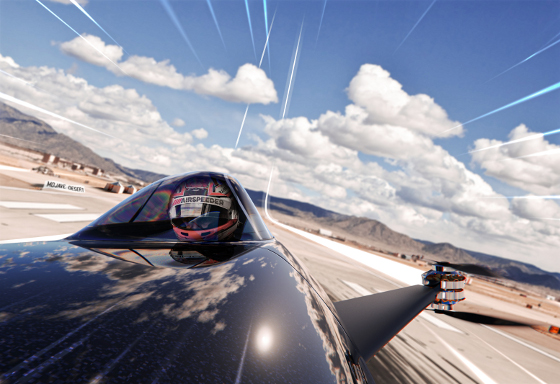
If you love fast and furious racing with a twist, hold on to your helmet. Full-size flying drone racers are coming -- and they aim to have human pilots soon. Welcome to the world of Airspeeder, where "Speeders" will zip from 0 to 60 in less than 3 sec and fly hundreds of meters in the air. The vehicles are being perfected in South Australia and have already flown.
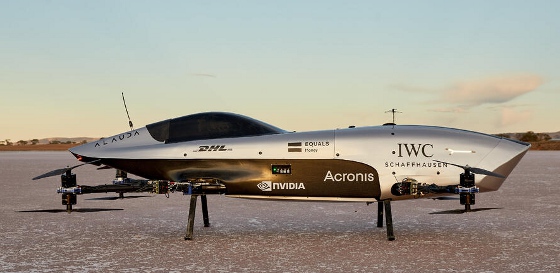
Matthew Pearson is the founder of Airspeeder and Alauda Aeronautics. Pearson began both endeavors in 2019. Airspeeder's aim is to provide the framework for the racing series and to champion the acceleration and development of electric vertical take-off and landing (eVTOL) technologies (way beyond simple drone deliveries), while Alauda was created to design and build the race vehicles. Both companies are located in Adelaide, Australia. According to Airspeeder, "The next-generation sport plays the same role the pioneers of Formula One did nearly a century ago in driving technical development and building public acceptance for a new mobility revolution."
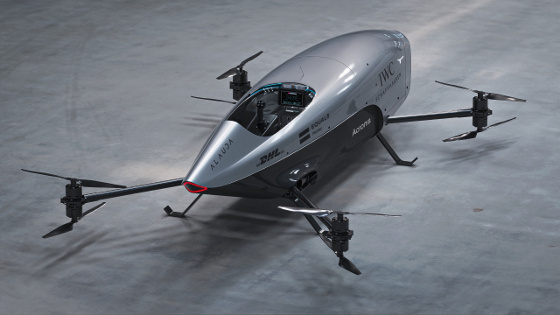
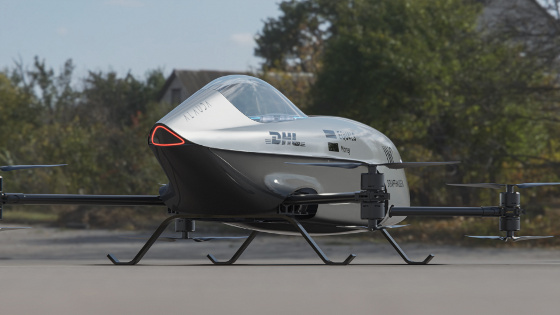
Airspeeder unveiled its Mk3 racing prototype at Goodwood Speed Week in West Sussex, England, this past May. The plan is for the Mk3 vehicles to be raced by the end of this year as unmanned vehicles using remote control from pilots on the ground. That will help the program work out the many possible kinks to this new form of 3D racing. All vehicles in the Airspeeder races EXA Series will be built by Alauda to the same specs, with individual pilots (virtual for now, onboard as soon as 2022) from various sponsoring companies.
Alauda is currently building 10 of these octocopter vehicles for races set to take place on three continents in the coming months. According to Airspeeder, "multiple teams and manufacturers will be provided the hardware by Alauda as a turnkey solution, but afforded freedon to set strategy and draft pilots." The first races for the series will start with two teams, though, and work their way to 10 over time.
Outdoor testing has been taking place in the South Australian deserts. Airspeeder made its first official flight in June 2021.
VIDEO: Fly along with the Alauda Mk3 electric flying racing car during its first flight test in South Australia.
The Airspeeder engineering and technical team is drawn from some of the leading names in performance and racing vehicle engineering including Mclaren, Tom Walkinshaw Racing, and Brabham. On the aviation side of the garage, members of the team have led major projects in both civil and military aviation, including Brett Hill's (project lead) experience as a flight dynamics specialist on the Boeing 747-8 program.
VIDEO: Airspeeder intro including interview with Airspeeder CCO Jack Withinshaw.
Royal Academy of Art graduate Felix Pierron, as the head of design at Alauda, was tasked with conceiving the form of the world's first electric flying racing car. His vision represents the marriage of an F1 car, a fighter jet, and a helicopter. In functional terms, when crewed racing begins in 2022 and beyond, the pilot will sit in the cockpit similar to how a driver is seated in a modern Formula 1 car. A lot of attention has been paid to the ergonomics of the cockpit to ensure the pilot's operational efficiency and safety.
Beyond the inspiration drawn from classic racing forms of the 1960s, the company says Pierron referenced "the Seaplanes that flew so gracefully and purposefully in the waters adjacent to Monaco in the Schneider Trophy, a major agent of progress at the dawn of the aviation age. The iconic Spitfire design language can be traced back to these races and are referenced today in Pierron's aesthetic treatment for the elegantly tapered front-third of the Airspeeder Mk3."
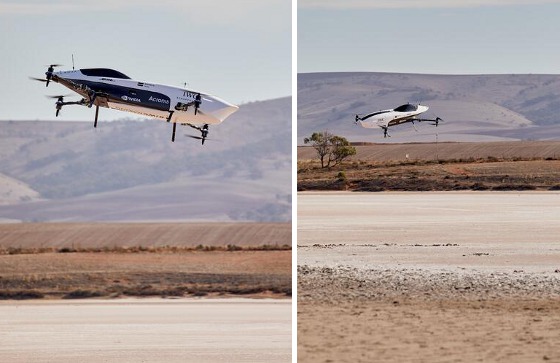
Airspeeder is working on pioneering a suite of technologies that will refine and demonstrate safety requirements, build acceptance for eVTOL, and, as a form of future transport, answer key questions around battery technology, noise, and regulation.
At the heart of this is the Mk3 vehicle. At maximum power, it delivers 320 kW, equal to an Audi SQ7 performance SUV. The Audi weighs 2,500 kg, while an Airspeeder racing craft (without pilot) weighs just 130 kg. Mk3 can lift a weight of more than 80 kg, proving the viability of the powertrain for piloted races. Acceleration from 0 to 62 mph takes 2.8 sec, and the Speeder can climb to 500 m. Unpiloted, the vehicle can reach speeds of 120 mph.
A Speeder can turn with extraordinary speed when compared to a traditional fixed-wing aircraft or helicopter. According to its makers, the Mk3 vehicle has a thrust-to-weight ratio of 3.5, which exceeds that of an F-15E Strike Eagle (thrust-to-weight ratio of 1.2). The thrust-to-weight ratio, along with other powertrain characteristics, has been verified as part of the exhaustive testing and development program that preceded the start of full production.
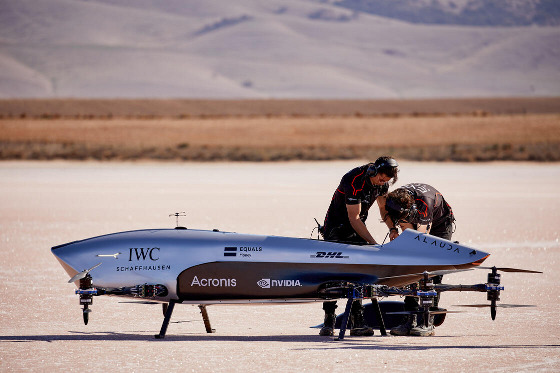
At the heart of the Mk3 is an advanced carbon fiber structure, which is both strong and lightweight. An Airspeeder vehicle consists of a chassis and carbon fiber molded tub-style skin.
VIDEO: How to make a carbon fiber shell for a racing eVTOL.
Of course, a lot of attention has been paid to battery development. Every Airspeeder race will include rapid pit stops, since the vehicle can only fly for 10 to 15 minutes and a full race could go to 45 min. To facilitate this, Alauda's engineers have developed an innovative "slide and lock" system for the rapid removal and replacement of batteries when on the ground. Power delivery profiles can be changed by ground crews to respond to the different requirements of the electronically governed sky-tracks that Airspeeder pilots will follow. For example, a layout that demands rapid maneuvers through sharp turns and ascents will require a different power delivery curve from those that demand outright straight-line speed. Ground crews will have to make instant decisions around sacrificing raw power for outright range. Airspeeder says test crews have gotten the battery-change pit stops down to as short as 14 sec.
VIDEO: Airspeeder's eVTOL battery power capacity explained.
Airspeeder employs a systems-based approach to safety. This means that no single operational failure can lead to loss of the primary function of the vehicle, which is controlled flight. In the early stages of the Mk3's development simulation, bench testing and integration testing techniques were employed to fully map out these systems. Ahead of live testing, this gave engineers confidence that in the event of a systems failure, vehicles will remain in the air but at reduced performance to ensure the pilot, whether operating remotely in the case of the Mk3, or in the cockpit in future iterations, will be able to safely return to the ground.
According to a recent TechCrunch article, "The Mk3 is flying under an experimental certification with Australia's Civil Aviation Safety Authority that means that while it must meet certain safety and airworthiness standards, the regulatory burden is far less than for a passenger aircraft."
VIDEO: How does data management drive the electric VTOL mobility revolution?
During flights, all systems are monitored on the ground through state-of-the-art telemetry. This means that ground crew are immediately aware of issues and can take appropriate action to bring the craft to ground under control. Other key technologies include LiDAR and radar collision-avoidance systems that create a "virtual forcefield" around the craft to ensure close but ultimately safe racing. All race vehicles will "talk" to each other too -- especially in a bid to keep a safe distance. Neither company has addressed, publicly, how crashes (however unlikely they say they may be) will be dealt with.
Terabytes of data from sensors within every area of the Speeder's architecture are drawn over any testing or racing cycle. This means on-the-ground pit crews are able to constantly analyze and react to even the smallest variance in performance. Airspeeder works with global cyber protection leader Acronis and their delivery partner Teknov8 to secure this data.
VIDEO: How to design dynamic eVTOL flight control systems.
Only time will tell if Airspeeder racing takes off and becomes a success, but the racing vehicles are really being made.It will be fun to see what happens.
Learn more at airspeeder.com.
Sources: Airspeeder, Alauda Aeronautics, TechCrunch
Published September 2021
Rate this article
View our terms of use and privacy policy
